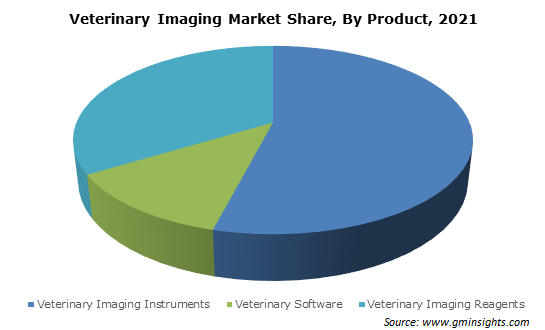Home > Animal Health & Nutrition > Veterinary Medical Devices > Veterinary Imaging Market
Veterinary Imaging Market Analysis
- Report ID: GMI4067
- Published Date: Jun 2022
- Report Format: PDF
Veterinary Imaging Market Analysis
The COVID-19 pandemic was noted to have largely disrupted the domestic as well as international supply chains, largely affecting the operations of all sectors and industries operating within. Local and national public authorities implemented stringent restrictions on the movement of people and goods. Hence, this negatively impacted the overall veterinary imaging market growth in the initial months of the pandemic.
Moreover, several veterinary procedures were termed as non-essential and limited visits for veterinary consultation were being observed, restricting the sales in the market. However, with the development of COVID-19 vaccines as well as active case count under control, several restrictions were lifted, and the market gained momentum by the second half of 2020. Furthermore, as a notable increase in pet adoption was observed throughout the year, this is expected to contribute to the long-term demand in the industry.
The demand in the veterinary imaging industry is increasing owing to an increasing number of fractures, surgeries, etc. Imaging technologies are essential to develop precise images related to animals’ abdominal cavities, chest, and bone structures. Such imaging equipment offer accurate, workflow optimization and high-quality images processing with greater resolution. These are also noted to be loaded with features such as zooming, image flipping, among others. Also, the technological advancements for improving products as well as ancillary services is expected to boost the overall market share.
High cost associated with the veterinary imaging instruments can potentially hinder the market growth over the forecast period. The cost of the imaging instruments depends upon the quality, size, shape, resolution power, among other variables. Further, the price for such instruments also varies largely based on new and refurbished equipment. The cost for low-field scanners ranges from USD 2,000 to 5,000 and that of radiography (X-ray) systems can range between USD 28,000 to 38,000.
Coupled with that, the veterinary imaging instruments require high maintenance. Thus, low affordability of such instruments and high maintenance costs poses threat to the market development.
Based on product, the industry is segmented into veterinary imaging instruments, veterinary software, and veterinary imaging reagents. The veterinary imaging instruments are further segmented into radiography (X-ray) systems, ultrasound systems, computed tomography systems, magnetic resonance imaging systems, video endoscopy imaging systems, among other imaging systems. In 2021, veterinary imaging instruments segment accounted for over 54% market proportion and is anticipated to remain dominant throughout the forecast period.
The addition of advanced imaging modalities such as digital radiography is obtaining immense popularity in veterinary medicine. This method is a fast and simple way to examine pets and requires relatively lesser time for processing images when compared to conventional film radiography. Thus, such benefits associated with radiography system is anticipated to drive the product demand.
Based on animal type, the market is divided into small companion animals, large animals, and other animals. Small companion animals segment accounted for over USD 823 million in 2021 and is expected to register considerable CAGR throughout the forecast period. The increasing pet adoption trends coupled with rising focus on providing optimum veterinary care services is largely driving the market growth for companion animals.
Additionally, the increasing penetration of pet insurance products increases the spending capacity of pet owners by reducing the out-of-pocket veterinary expenses. Owing to such aforementioned factors, the companion animals segment is anticipated to register a significant CAGR throughout the forecast period.
Orthopedics and traumatology segment accounted for a significant market proportion in 2021 and is expected to register nearly 6.2% CAGR between 2022 to 2030. Orthopedics and traumatology reflect the clinical and experimental aspects in dogs and cats. Its prime focus is given toward fracture treatment, joint luxation, congenital disorders, degenerative disease, limb deformity among others. Several retrospective studies report the prevalence rate of bone fracture among companion animals.
For instance, a study conducted between 2013 and 2016 reported around 1,780 out of 106,286 dogs (1.67%) and 255 out of 22,258 cats (1.13%) were diagnosed for bone fracture. Under the age of one year, over 50% of bone fractures occurred in dogs and nearly 70% in cats.
Further, road traffic accidents were noted to be one of the leading causes of bone fracture among companion animals. Hence, the increasing prevalence of bone fracture is noted to supplement the market demand for imaging solutions.
Based on end-use, the veterinary imaging market is segmented into hospitals, clinics, and others. The hospitals segment accounted for a prominent market proportion in 2021 and is expected to register sales worth over USD 1.4 billion by 2030. Hospitals are noted to possess a higher spending capacity as compared to clinics and hence, can readily procure, install and main multiple veterinary imaging equipment. The increasing government focus towards establishing advanced, well-equipped medical infrastructure with optimum facilities is another factor driving the segmental revenue.
Additionally, hospitals have historically represented a relatively higher adoption rate towards novel technologies, including those of veterinary imaging. Hence, these factors are essentially noted to drive the market growth throughout the forecast period.

North America veterinary imaging market surpassed USD 712.1 million in 2021 and is anticipated to register a lucrative CAGR throughout the forecast period. Increasing pet adoption is driving the pet population in the U.S. For instance, according to American Pet Products Association 2021-2020 National Pet Owners Survey, about 90.5 million households in the U.S. own a pet with nearly 69 million dogs and 45.3 million cats. In addition, growing number of veterinary practitioners, due to the high demand for veterinary services also contributes to the rising demand.
Furthermore, the rise in burden of zoonotic diseases such as zoonotic influenza, west nile virus, plague, rabies, brucellosis, among other diseases are highly prevalent among pets in the U.S. Therefore, the mentioned factors are expected to accelerate the regional market statistics.

